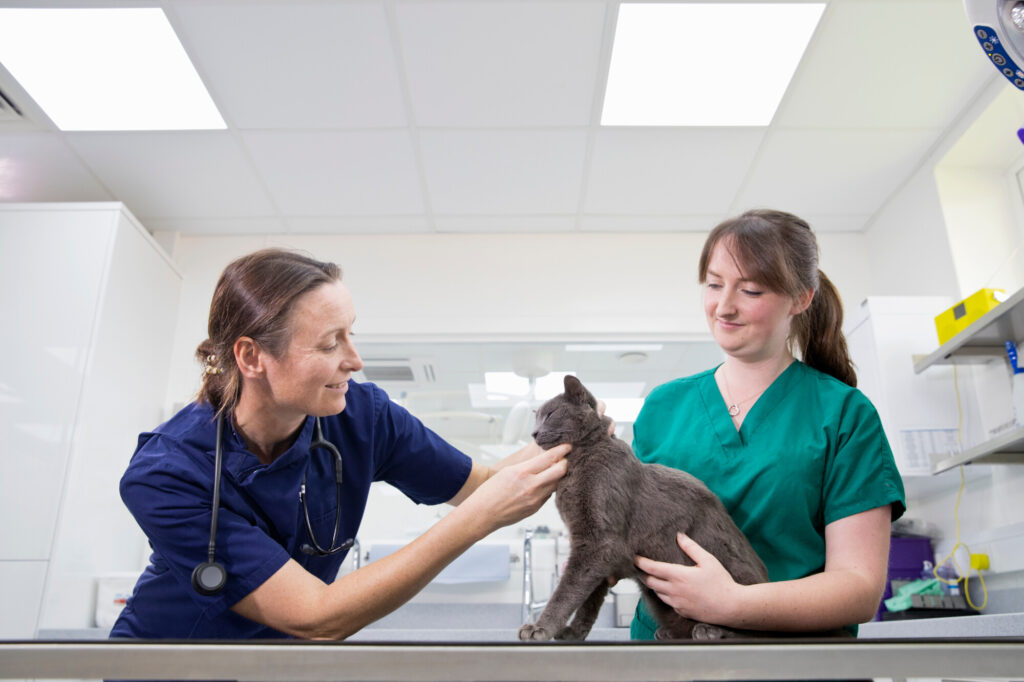
You’ve probably heard Bob Barker or Drew Carey say it over and over again on The Price is Right game show, “Help control the pet population, have your pet spayed or neutered.” No, this isn’t just some kitschy catchphrase. Spaying and neutering are vital ways to manage the population control of cats and dogs.
Kittens and puppies are adorable, there’s no denying it. But each year animal shelters become overloaded with unwanted litters of puppies and kittens as a result of overpopulation. If they aren’t adopted, 41% of cats and 31% of dogs each year can face the heartwrenching reality of euthanization.
As a pet owner, it’s crucial that you make the right choice by spaying and neutering your pets. If you don’t know what this means or what the process entails, this informative guide can help. Keep reading below to learn more important information about spaying and neutering your precious furbabies.
Spaying and Neutering Dogs: What You Need to Know
Spaying and neutering are both elective surgical procedures. Spaying and neutering your dog can seem cruel on the surface, but it is a significant part of pet population control for both male and female dogs. It also offers certain medical and behavioral benefits for your pooches.
Let’s further explore the differences between spaying and neutering dogs here.
Spaying 101: Female Dogs
Spaying is the term used to denote the procedure for sterilizing a female dog. It is also commonly referred to as “fixing.” When a female dog is spayed, she undergoes a surgery to remove her reproductive organs.
One intact female dog can have between 1-12 puppies with around 5-6 puppies in an average litter. However, it is possible to have upwards of 15 puppies or more. Spaying prevents unwanted puppies from ending up in shelters or getting euthanized.
The most common form of spaying in a female dog is called an Ovariohysterectomy. This removes the parts that are most impactful to reproduction and includes the:
- Ovaries
- Fallopian Tubes
- Uterus
There is another variation of spaying called Ovariectomy that only involves removing the ovaries. This leaves the uterus intact. You should discuss the benefits and risks of each procedure with your professional Veterinarian ahead of time.
What Happens During the Spaying Surgery?
When you bring your female dog in for her spaying surgery, they will be under strict orders not to eat or drink anything prior to the procedure.
Your dog is then taken to a pre-op room where the staff will do a wellness check and take her vitals. They will start an IV line to provide hydration and to administer medications intravenously.
Your dog will be under general anesthesia so she won’t feel any pain during the surgery. A breathing tube is also placed down her throat and her vitals will be closely monitored.
The vet techs will shave and sanitize the stomach area. Your veterinarian will then make an incision below your dog’s umbilical or belly button area and remove the reproductive organs and then stitch the area back up.
Spaying Post-Op and Recovery
Your dog will be able to go home from the veterinary hospital within a few hours if she is doing well. You may receive pain medication to administer post-op so your dog stays comfortable while she recovers. She may also need to wear a cone or padded collar to prevent her from licking or biting at the incision.
It is normal for your female dog to feel sleepy and out of it. This can improve within 24-48 hours after surgery but you should monitor them for any signs of distress or infection. Your dog should still refrain from strenuous activity for up to 2 weeks.
Your vet may want you to check up with them within a week to 10 days. This is to check the incision or to remove any sutures or stitches that aren’t self-dissolving.
What Age Is Recommended for Spaying a Female Dog?
It is recommended that you wait for your smaller female dog to reach at least 6 months of age before spaying. In larger dog breeds, it depends on when they have reached their full-grown size. This can vary from breed to breed, anywhere from 12-24 months of age.
It is also advisable to get a female dog spayed before her first heat which reduces the risk of mammary tumors. Female dogs who are not spayed will go through a heat cycle every 6 months.
Your dog should not be in an active heat cycle if she is to undergo a spaying procedure. You will need to wait for the heat to pass first.
Health and Behavioral Benefits of Spaying a Female Dog
Spaying a female dog can greatly reduce the chances of getting mammary cancer. This condition is fatal in 50% of female dogs.
Spaying can also cut down on the erratic behavior that comes with heat cycles. This includes aggressive behavior, frequent urination, trying to run away from home, and howling or crying.
Neutering 101: Male Dogs
On the other side of the spaying and neutering discussion is the procedure for male dogs. Just like spaying removes a female dog’s reproductive organs, neutering removes the male organs known as the testes. This is also called castration.
One intact male can impregnate multiple females at a time, leading to an explosion in puppy births. Neutering a male dog is a must as a form of population control by a responsible pet owner.
What Happens During the Neutering Surgery?
As with spaying, neutering a male dog requires no eating or drinking by your pet before the surgery. You will bring your dog to the veterinary hospital where they will ensure that he is in good condition to undergo the procedure.
They will start an IV and administer medicine to help him relax. Your dog will then be put under general anesthesia so he won’t feel any pain. A breathing tube will be placed to keep the airway open while trained vet techs monitor your dog’s vital signs.
The area is also shaved and prepped with antiseptic. The veterinarian will make a small incision in the male dog’s scrotum and remove the testicles. They will then suture the incision closed.
Neutering Post-Op and Recovery
Your dog will go to recovery where he will slowly wake up from anesthesia. He will need to wear a padded collar or cone to keep him from licking or biting the incision site while it heals.
Your vet may give you pain medication to help your dog with post-operative pain. Take your dog directly home and let them recover, making sure to watch for signs of post-op complications as instructed by your vet.
Your dog will need to recover for up to 2 weeks before they can resume normal activities. You may need to schedule an appointment to bring them back in for a check-up in about a week for the vet to inspect the incision or remove any non-dissolving stitches.
What Age Is Recommended for Neutering a Male Dog?
Smaller dogs mature much sooner than larger dogs so it can vary on a breed-to-breed basis. For example, smaller dogs may be able to get neutered as young as 4 months old. The general consensus is around 6-9 months or up to 12 months of age for lap dog and toy varieties.
Large and giant breed male dogs are eligible for neutering at anywhere from 16-18 months. You should ask your veterinarian what their professional option is, based on your dog’s breed, age, and overall health factors.
Health and Behavioral Benefits of Neutering a Male Dog
Aside from vast population control, neutering has other health and behavioral benefits. An unneutered male will often try to roam or escape from home in search of a female in heat. They may also try to obsessively hump or mount other people or pets and act out aggressively toward other male dogs.
Neutering can cut back on these disruptive behaviors. Neutering also reduces the destructive behavior of territorial marking with urine.
The health benefits of neutering a male dog include reducing the risks of developing hernias. It can also lessen the chances of getting prostatic disease, pancreatic cancer, and testicular cancer.
Spaying and Neutering Cats: What You Need to Know
Cats can also undergo spaying and neutering procedures similar to dogs. Cats are avid breeders and can quickly lead to overpopulation. The ASPCA, of the 7.6 million animals in shelters each year, an estimated 3.4 million are cats.
Spaying and neutering cats leads to better population control. Cats who are spayed and neutered also reap many health and behavioral benefits as well.
Spaying 101: Female Cats
Female cats generally go into heat when the weather is nicer. The months of March through October in warmer climates see an influx of kittens in shelters. This is often referred to as Kitten Season.
This is why it is so essential to spay female cats. Removing their reproductive organs makes it so they can’t reproduce en masse.
What Happens During the Spaying Surgery?
Spaying a cat is also a supervised surgical procedure done under a general anesthetic. Your cat must fast from consuming food and water for safety before the surgery.
An IV will be placed and your cat will be asleep for the entire surgery. Their vitals are closely monitored while they are on a breathing tube.
The belly will be shaved and an incision will be made by the veterinarian to remove the female cat’s reproductive organs. The area will then be sewn back up again with stitches or sutures.
Spaying Post-Op and Recovery
You can take your cat home after a few hours. You may need to give them pain medicine to keep them comfortable. A cone or padded safety collar will keep them from licking the wound.
They may start to feel better within a few days. Attention should still be paid to ensure they don’t do anything too strenuous like jumping around for 10 to 14 days.
What Age Is Recommended for Spaying a Female Cat?
Cats can be sexually mature as young as 4 months old. So, it is possible for a female kitten to have a litter of kittens of their own. Not only is this dangerous for a kitten this young, but it adds to an increasingly growing overpopulation problem.
Get your kitten evaluated at a Kitten Wellness Check-Up or vaccination visit. Your vet will advise you if your kitten is healthy enough to consider getting the spaying surgery.
Health and Behavioral Benefits of Spaying a Female Cat
Spaying cuts down on aggressive behaviors due to the hormone fluctuations of going into multiple heats. Like a female dog, cats in heat can also try to run away from home to get pregnant, loudly yowling to signal a potential mate, rolling around, urine spraying, rubbing aggressively, and acting agitated. Spaying takes away these troublesome behaviors.
Spaying a female cat reduces the occurrence of mammary tumors. These can be especially fatal for 90% of cats. There are also fewer uterine and urinary infections.
Neutering 101: Male Cats
As with male dogs, neutering involves castrating or removing a male’s sex organs, the testicles. Taking out the testicles removes a male cat’s ability to reproduce with female cats in heat. This cuts down on their capacity to sire many litters of kittens.
What Happens During the Neutering Surgery?
During a neutering procedure, the male cat receives an IV and gets put under general anesthesia. They are also given a breathing tube.
The scrotum is shaved and prepped with an antiseptic cleanser to prevent infection. The veterinarian then makes an incision into the scrotum to remove the testicles. The area is then sutured shut.
Neutering Post-Op and Recovery
Take your cat home afterward and let them rest somewhere comfortable, quiet, and safe. Your vet may outfit them with a cone or padded collar to keep them from licking the area.
Your vet may also give you pain medication to give your cat as they recover. Watch the incision site for any signs of infection or tearing.
A simple cat neutering can take between 7-10 days for your cat to recover from. This is because it is less invasive than a female’s abdominal procedure.
What Age Is Recommended for Neutering a Male Cat?
A male kitten may be eligible for neutering around 5-6 months of age. Some vets may advise you to wait until the kitten reaches the age of 6-8 months. They should also undergo a Kitten Wellness Check and receive all of their necessary vaccinations.
Health and Behavioral Benefits of Neutering a Male Cat
Male cats with their testicles intact are prone to bouts of aggression and excessive urine-spraying habits. They become extremely territorial and will seek out other male cats or stray dogs to fight with, which can lead to serious injuries. Unaltered male cats will also roam from home and can become victims of car accidents while wandering the streets.
Neutered cats will have a calmer demeanor overall. The health benefits of neutering also include a decreased likelihood of testicular cancer and prostate disease.
Experience High-Quality Service for Your Pet at Slaton Veterinary Hospital
Spaying and neutering your pets is a significant part of the pet ownership experience. You’re giving your pet the best possible chance to be healthier and happier while also aiding in pet population control.
Slaton Veterinary Hospital is your other family doctor for your four-legged companions in beautiful Westlake Village, CA. We welcome you to our state-of-the-art facility where we strive for the highest quality care possible. From welcoming and caring for new kittens and puppies to tending to more senior wellness needs, we’re here for it all.
Contact us about your pet’s veterinary needs and come visit us today.
Search
Categories
- Cat Care 3
- Dental Care 1
- Uncategorized 1
- Veterinarian 29
Recent Posts
-
Westlake Animal Hospital: Premier Veterinary Care in Westlake Village
-
Pet Microchip 101: Your Ultimate Guide to Keeping Dogs and Cats Safe
-
Cat Care Essentials: How to Keep Your Feline Friend Happy and Healthy
-
Expert Dog Surgery in Ventura County: What Every Pet Parent Should Know
-
The Importance of Regular Wellness Exams for Your Pet’s Health




